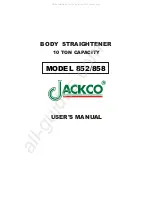
Section 2: Operating Procedures
GB2590, GB2596, GB25108, GBE2590, GBE2596, & GBE25108 Grapple Buckets 380-192M
3/3/20
25
General Operating Instructions
By now you should have familiarized yourself with the
Operator’s Manual for your Grapple Bucket. If you
haven’t, please do so now. If someone else is operating
the tractor and Grapple Bucket, make sure they read and
fully understand this manual. We cannot overstress the
importance of following the safety operating procedures
spelled out in this manual.
Before you begin carrying materials with your Grapple
Bucket, make sure the back of the tractor has enough
weight to counter-balance the overhanging weight on the
front loader. Without this weight, the tractor could tip
causing damage to the equipment and serious personal
injury or death to the operator. This weight may be
attained with ballast in the rear tires or by adding weights
to the rear wheels. Check your tractor Operator’s Manual
or see your nearest tractor dealer to determine the best
method and correct weights to add.
You will want to determine the path you will be traveling
and to check for overhead obstructions such as low
hanging branches and electrical wires. Also check for
drop offs, holes, rocks, stumps and other protrusions that
could flip the tractor. Mark problem areas with flags and/
or warning signs indicating potential problems.
Proceed by getting onto the seat of your tractor and
starting it up. It isn’t going to take you long to learn how to
use your new Land Pride Grapple Bucket. As you quickly
become skilled and adept in using your Grapple Bucket,
you will soon learn that it is important to approach the
load being picked up with the bucket low and to come to
a full stop in front of the load before maneuvering the
bucket and grapple. While stopped, position the bucket at
the proper height and open the grapple. Once the
grapple is opened, proceed slowly into the load to fill the
bucket. Stop to close the grapple and contain the load.
With the load contained, slowly raise the bucket up
several inches and tilt it back slightly. Check the load to
make sure it is secured. Make sure no one is behind or on
either side of tractor. Back the load out slowly while
watching for pedestrian traffic and other obstacles that
might get in the way. Once free, stop and recheck the
load to see if it is properly secured. If not, release the load
and re-clamp it to make it more secure.
You are now ready to start traveling with the load. Before
starting your journey, position the load at a safe, low
traveling height with the bucket tilted back slightly. Avoid
fast starts and travel at a speed that does not shake the
load around causing it to break loose and fall from your
bucket. It is also important that you travel at a speed that
does not make it difficult to control the tractor. While you
are transporting, continually scan all sides for
pedestrians and other traffic. Also watch for drop-offs,
holes, rocks, stumps, and other protrusions that could
make the load or tractor unstable. Reduce speed when
turning corners and watch to make sure the load does not
swing into objects such as fences, trees, and buildings.
Remember, it is safer for you and less destructive to your
equipment and load to not hurry.
As you approach your unloading site, start slowing the
tractor down gradually. Come to a complete idle and then
stop in front of the location the load is to be released.
Slowly raise the load to the required height for releasing.
Make sure there are no people or animals around as you
move forward slowly to position the load above its final
release zone. Stop to release the load. Releasing the
load requires a combination of tilting the front of the
bucket down, opening the grapple up, and raising the
loader arms to clear the released material. The order in
which the load is released will vary depending on type of
material being released. The most important objective is
to have the load under control throughout the release.
Once the load has settled, slowly back up making sure
the bucket clears all objects and there are no pedestrians
or other traffic behind or on either side of the tractor and
bucket. When the tractor and bucket is completely
removed from the released load, you can readjust the
bucket and grapple to a safe low traveling height and
return to the field to pick up your next load.
In no time at all, you will find that you will quickly
become very adept, handy, and skillful at using your new
Land Pride Grapple Bucket.
See
“Specifications & Capacities”
on page 29 and
“Features & Benefits”
on page 30 of your Operator’s
Manual for additional information.










































